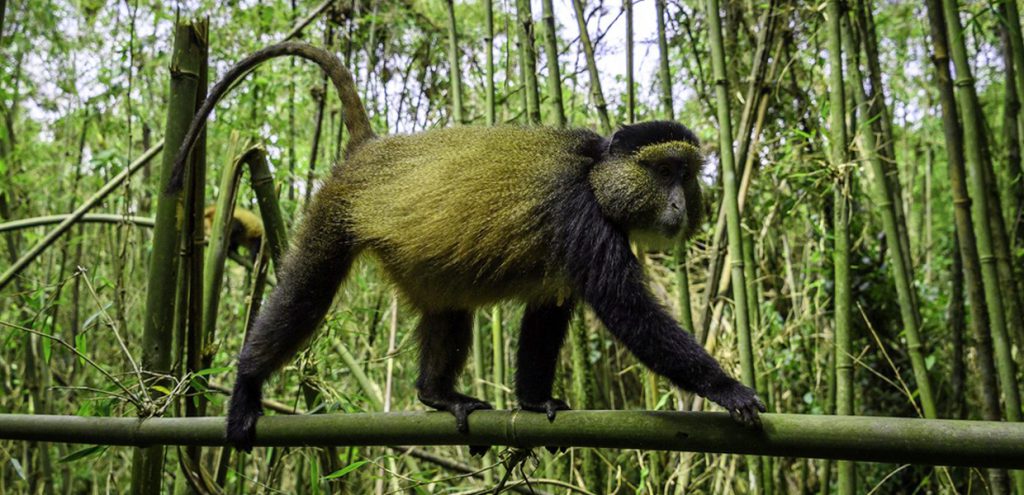The experience of encountering the frisky golden monkeys up-close in their natural habitats is indescribable and is only possible in the Virunga Conservation Area. Their swiftness while jumping on tree branches or chewing on bamboo, their exciting daily routines, beautiful color and playful tricks are some of the reasons why Primate lovers always add them on their must-see list.

Golden monkeys are “endangered” under the IUCN Red List and scientifically known as “Cercopithecus Mitis Kandti”. They are sub-species of the Sykes monkeys that are endemic to the verdant Bamboo Zone of Virunga Mountains. Golden monkeys are playful and curious creatures that spend the most part of their day swinging from one tree branch to another.
Golden monkeys live in the Virunga Conservation Area (occupying the Bamboo-dominated lower slopes of the Virunga Volcanoes) but are mainly tracked in Uganda’s Mgahinga Gorilla National Park (the smallest Park in the country covering are area of 3400 hectares within the south-western side) and Rwanda’s 160-square-kilometer Volcanoes National Park set in the Northern province.
Interesting things to know about Golden Monkeys
They are scientifically known as “Cercopithecus mitis kandti” and are part of the Cercopithecidae family. These herbivores feed on 20-30 plant species although their all-time favorite is bamboo-leaves, shoot, and branchlets. Golden monkeys also feed on other succulent leaves, flowers, fruits, shrubs, insects, and different invertebrates.
Golden monkeys are categorized as “endangered” under the IUCN Red List with their main threats being habitat loss, poaching, and diseases.
These “Old World Monkeys” species are characterized by a beautiful golden-brown parch extending from their long tails to backs and on the cheeks. Their natural habitats are found on the lower slopes of Virunga Volcanic Mountains of East and Central Africa. Sexual dimorphism is exhibited by golden monkeys, in that the females are incredibly lighter than their male counterparts.
The gestation period of these unique primates is 5 months with newborns having little fur and wide open eyes. The life span of golden monkeys is 19 years.
Golden monkeys live in large troops of 30 to 100 individuals.
Golden Monkey tracking in Uganda
The 34-square-kilometer Mgahinga Gorilla National Park is the only place where you can track the endangered golden monkeys in Uganda with two troops currently habituated.
A typical golden monkey tracking day in Mgahinga Gorilla National Park starts with briefing at Ntebeko Visitor Center at about 7:00am. At 8:00am, you start hiking through the lower slopes of Virunga Volcanoes and within only 1-3 hours, the allocated golden monkey troop will be found. Just like with gorillas, you will spend one hour learning, watching and photographing them. 12 years is the minimum age limit for golden monkey tracking in Uganda but also requires basic fitness levels.
Permits go for $60 per person per trek for the foreign non-resident, $50 per person for foreign residents and Shs. 40,000 for East African Community travelers.The permits are only issued by Uganda Wildlife Authority, although can be purchased through a credible Tour Operator. For the accommodation options in Mgahinga Gorilla National Park, there is Mount Gahinga Lodge, Lake Mulehe Safari Lodge, Kisoro Travelers Rest Camp, Amajambere Iwacu Camp, Kisoro Tourist Hotel, and Mucha Hotel among others.
Golden Monkey tracking in Rwanda
There are currently two habituated golden monkey troops in Rwanda’s Volcanoes National Park and each one is made up of 80 to 100 individuals. One troop lives at the foothills of Sabyinyo Volcano.
The starting point for golden monkey tracking in Volcanoes National Park is Kinigi Park Headquarters, beginning with registration and briefing at 7:00am, followed by the drive to the trailhead before embarking on the actual adventure. Tracking time is quite unpredictable but it will range from 1-4 hours depending the movement of these creatures and slowest person’s pace.
Golden monkey tracking fees for Rwanda are 100 per person per trek, and these include Park entry fees, Ranger guide but not tips, porter fees, transportation or accommodation.
Rwanda’s remarkable places of stay while undertaking golden monkey tracking are Bisate Lodge, One & Only Gorilla’s Nest, Virunga Lodge, Amakoro Songa Lodge, Muhabura Hotel, Singita Kwitonda Lodge, Five Volcanoes Boutique Hotel, Villa Gorilla, Le Bambou Gorilla Lodge, Kinigi Guesthouse, Sabyinyo Silverback Lodge, Mountain Gorilla View Lodge, Da Vinci Gorilla Lodge, Bishop’s House, to mention but a few.
When is the best time of the year to go for Golden Monkey tracking in Uganda?
Golden Monkey Tracking in Uganda and Rwanda is possible all year round, although there are varying experiences during each season.
Tracking during the dry season-(June to September and December through February) is marked by drier and less muddy or slippery forest trails as precipitation levels have reduced. However, this is the peak season and the demand for accommodation is so high thus advance booking is important.
Golden monkey tracking during the wet season (March-May and October to November) is marked by muddier and slippery forest trails due to heavy rains thus making the activity more challenging. The good news however is that you are likely to enjoy discounted rates on accommodation and treks become shorter as the golden monkeys have plenty of food (vegetation) thus won’t move to higher places.
What you need for Golden Monkey tracking in Uganda and Rwanda
Golden monkey tracking generally involves hiking through Virunga Mountain slopes and dense Bamboo vegetation, which sometimes become wet and muddy. Therefore, you will need a pair of sturdy hiking boots with ankle support, gaiters, energy-giving snacks, cotton socks, long safari pants, long-sleeved shirt, a lightweight rain jacket, insect repellant, sunscreen, a safari hat, sunscreen, gardening gloves, a basic first aid kit, waterproof backpack, toiletries (toothbrush, hand and body lotion, toothpaste, hair comb, hand sanitizer, wet wipes, deodorant, hand towel, to mention but a few), sunglasses, re-usable water bottle, to mention but a few.
